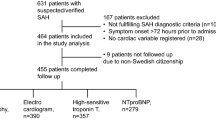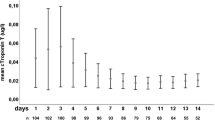Abstract
Several studies have demonstrated the usefulness of cardiac troponin I (cTn) levels in predicting adverse clinical outcomes of patients with anerusmal subarachnoid hemorrhage (aSAH). However, it remains unclear whether cTn levels can be a useful factor in predicting adverse neurologic and cardiovascular outcomes regarding follow-up duration. The study aimed to evaluate the clinical value of cTn elevation among patients with aSAH. A systematic literature search was performed in PubMed and Cochrane to collect original studies that compared the adverse outcomes in patients with aSAH who had elevated cTn levels and those who did not have elevated cTn levels. Data on patient demographics and outcome measurements (mortality, major disability, delayed cerebral ischemia, cardiac dysfunction, and pulmonary edema) were extracted. Pooled odds ratios (ORs) and 95% confidence intervals (CIs) were computed by fitting a random effects model. A total of 4,117 patients with aSAH were included in the meta-analysis. Elevated cTn levels was associated with a higher all-cause mortality (OR 3.64; 95% CI 2.68–4.94; I2 = 22.05%), poor major disability (OR 2.27; 95% CI 1.5–3.37; I2 = 52.07%), delayed cerebral ischemia (OR 2.10; 95% CI 1.46–3.03; I2 = 13.80%), cardiac dysfunction (OR 9.20; 95% CI 4.31–19.60; I2 = 39.89), and pulmonary edema (OR 10.32; 95% CI 5.64–18.90; I2 = 0.00%). Additionally, elevated cTn levels was associated with higher mortality in prospective studies (OR 3.66; 95% CI 2.61–5.14) as well as when compared with studies with short-term and long-term follow-up periods. Patients with aSAH who had elevated cTn levels also tended to experience poor short-term major disability (OR 2.36; 95% CI 1.48–3.76). Among patients with aSAH, elevated cTn levels was associated with higher mortality and adverse neurologic and cardiovascular outcomes. Given its clinical value, cardiac troponin levels may be included in the assessment of patients withs aSAH.








Similar content being viewed by others
References
Hop JW, Rinkel GJ, Algra A, van Gijn J. Case-fatality rates and functional outcome after subarachnoid hemorrhage: a systematic review. Stroke. 1997;28(3):660–4.
Bruder N, Rabinstein A. Cardiovascular and pulmonary complications of aneurysmal subarachnoid hemorrhage. Neurocriti Care. 2011;15(2):257–69.
Mavridis IN, Meliou M, Pyrgelis E-S. Troponin elevation in subarachnoid hemorrhage. J Acute Dis. 2015;4(1):7–11.
Zhang L, Wang Z, Qi S. Cardiac troponin elevation and outcome after subarachnoid hemorrhage: a systematic review and meta-analysis. J Stroke Cerebrovasc Dis. 2015;24(10):2375–84.
Zhang L, Zhang B, Qi S. Impact of echocardiographic wall motion abnormality and cardiac biomarker elevation on outcome after subarachnoid hemorrhage: a meta-analysis. Neurosurg Rev. 2020;43(1):59–68.
Brouwers PJ, Westenberg H, van Gijn J. Noradrenaline concentrations and electrocardiographic abnormalities after aneurysmal subarachnoid haemorrhage. J Neurol Neurosurg Psychiatry. 1995;58(5):614–7.
Deibert E, Barzilai B, Braverman AC, et al. Clinical significance of elevated troponin I levels in patients with nontraumatic subarachnoid hemorrhage. J Neurosurg. 2003;98(4):741–6.
Parekh N, Venkatesh B, Cross D, et al. Cardiac troponin I predicts myocardial dysfunction in aneurysmal subarachnoid hemorrhage. J Am Coll Cardiol. 2000;36(4):1328–35.
Naidech AM, Kreiter KT, Janjua N, et al. Cardiac troponin elevation, cardiovascular morbidity, and outcome after subarachnoid hemorrhage. Circulation. 2005;112(18):2851–6.
Schuiling W, Dennesen P, Tans JTJ, et al. Troponin I in predicting cardiac or pulmonary complications and outcome in subarachnoid haemorrhage. J Neurol Neurosurg Psychiatry. 2005;76(11):1565–9.
Pereira AR, Sanchez-Peña P, Biondi A, et al. Predictors of 1-year outcome after coiling for poor-grade subarachnoid aneurysmal hemorrhage. Neurocrit Care. 2007;7(1):18–26.
Ramappa P, Thatai D, Coplin W, et al. Cardiac troponin-I: a predictor of prognosis in subarachnoid hemorrhage. Neurocrit Care. 2008;8(3):398–403.
Sandhu R, Aronow WS, Rajdev A, et al. Relation of cardiac troponin I levels with in-hospital mortality in patients with ischemic stroke, intracerebral hemorrhage, and subarachnoid hemorrhage. Am J Cardiol. 2008;102(5):632–4.
Tanabe M, Crago EA, Suffoletto MS, et al. Relation of elevation in cardiac troponin I to clinical severity, cardiac dysfunction, and pulmonary congestion in patients with subarachnoid hemorrhage. Am J Cardiol. 2008;102(11):1545–50.
Hravnak M, Frangiskakis JM, Crago EA, et al. Elevated cardiac troponin I and relationship to persistence of electrocardiographic and echocardiographic abnormalities after aneurysmal subarachnoid hemorrhage. Stroke. 2009;40(11):3478–84.
Jeon I-C, Chang C-H, Choi B-Y, et al. Cardiac troponin I elevation in patients with aneurysmal subarachnoid hemorrhage. J Korean Neurosurg Soc. 2009;46(2):99.
Ichinomiya T, Terao Y, Miura K, et al. QTc interval and neurological outcomes in aneurysmal subarachnoid hemorrhage. Neurocritic Care. 2010;13(3):347–54.
Miketic JK, Hravnak M, Sereika SM, Crago EA. Elevated cardiac troponin I and functional recovery and disability in patients after aneurysmal subarachnoid hemorrhage. Am J Crit Care. 2010;19(6):522–8 (quiz 9).
Degos V, Apfel CC, Sanchez P, et al. An admission bioclinical score to predict 1-year outcomes in patients undergoing aneurysm coiling. Stroke. 2012;43(5):1253–9.
Ahmadian A, Mizzi A, Banasiak M, et al. Cardiac manifestations of subarachnoid hemorrhage. Heart Lung Vessel. 2013;5(3):168.
Gupte M, John S, Prabhakaran S, Lee VH. Troponin elevation in subarachnoid hemorrhage does not impact in-hospital mortality. Neurocrit Care. 2013;18(3):368–73.
van der Bilt I, Hasan D, van den Brink R, et al. Cardiac dysfunction after aneurysmal subarachnoid hemorrhage: relationship with outcome. Neurology. 2014;82(4):351–8.
Duello KM, Nagel JP, Thomas CS, Blackshear JL, Freeman WD. Relationship of troponin T and age-and sex-adjusted BNP elevation following subarachnoid hemorrhage with 30-day mortality. Neurocrit Care. 2015;23(1):59–65.
Nastasovic T, Milakovic B, Marinkovic JE, Grujicic D, Stosic M. Could cardiac biomarkers predict neurogenic pulmonary edema in aneurysmal subarachnoid hemorrhage? Acta Neurochir. 2017;159(4):705–12.
Akkermans A, Peelen LM, van Waes JA, Rinkel GJ, van Klei WA. Cardiac events within one year after a subarachnoid haemorrhage: the predictive value of troponin elevation after aneurysm occlusion. Eur J Prev Cardiol. 2019;26(4):420–8.
Alkhachroum AM, Miller B, Chami T, Tatsuoka C, Sila C. A troponin study on patients with ischemic stroke, intracerebral hemorrhage and subarachnoid hemorrhage: type II myocardial infarction is significantly associated with stroke severity, discharge disposition and mortality. J Clin Neurosci. 2019;64:83–8.
Guette P, Launey Y, Arnouat M, et al. Prognostic value of high-sensitivity troponin T in aneurysmal subarachnoid hemorrhage: a prospective observational study. Brain Inj. 2019;33(10):1372–8.
Lin F, Chen Y, He Q, et al. Prognostic value of elevated cardiac troponin I After aneurysmal subarachnoid hemorrhage. Front Neurol. 2021;12:19.
Bender M, Stein M, Schoof B, et al. Troponin I as an early biomarker of cardiopulmonary parameters during the first 24 h of intensive care unit treatment in isolated traumatic brain injury patients. Injury. 2020;51(5):1189–95.
Thygesen K, Alpert JS, Jaffe AS, et al. Fourth universal definition of myocardial infarction (2018). Eur Heart J. 2019;40(3):237–69.
Chapman AR, Adamson PD, Mills NL. Assessment and classification of patients with myocardial injury and infarction in clinical practice. Heart. 2017;103(1):10–8.
Tung P, Kopelnik A, Banki N, et al. Predictors of neurocardiogenic injury after subarachnoid hemorrhage. Stroke. 2004;35(2):548–51.
Zahid T, Eskander N, Emamy M, Ryad R, Jahan N. Cardiac troponin elevation and outcome in subarachnoid hemorrhage. Cureus. 2020;12(8):69.
Morrow A, Ahmad F, Steele C, McEntegart M, Murdoch D. Treating the troponin: adverse consequences of over-treatment of elevated troponin in non-coronary presentations. Scott Med J. 2019;64(1):10–5.
McAuley L, Tugwell P, Moher D. Does the inclusion of grey literature influence estimates of intervention effectiveness reported in meta-analyses? Lancet. 2000;356(9237):1228–31.
Funding
This study received no funding.
Author information
Authors and Affiliations
Contributions
Concept and design: Ali Seifi, Sahar Memar Montazerin, and Gerald Chi. Acquisition, analysis, or interpretation of data: Sahar Memar Montazerin, Gerald Chi, and Jane J. Lee. Drafting of the article: Roghayeh Marandi, Homa Najai, and Fahimehalsadat Shojaei. Critical revision of the article for important intellectual content: Ali Seifi, Jolanta Marszalek, and Sahar Memar Montazerin. All authors have read and agreed to the final version of the manuscript.
Corresponding author
Ethics declarations
Conflicts of interest
The authors have no conflicts to disclose.
Additional information
Publisher's Note
Springer Nature remains neutral with regard to jurisdictional claims in published maps and institutional affiliations.
Sahar Memar Montazerin, Gerald Chi these authors are Co-first authors.
Supplementary Information
Below is the link to the electronic supplementary material.
Rights and permissions
About this article
Cite this article
Memar Montazerin, S., Chi, G., Marandi, R. et al. Evaluation of Cardiac Troponin and Adverse Outcomes After Aneurysmal Subarachnoid Hemorrhage: A Systematic Review and Meta-Analysis. Neurocrit Care 36, 650–661 (2022). https://doi.org/10.1007/s12028-021-01368-0
Received:
Accepted:
Published:
Issue Date:
DOI: https://doi.org/10.1007/s12028-021-01368-0




